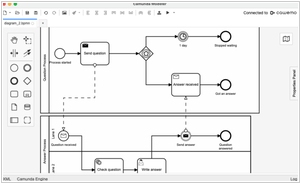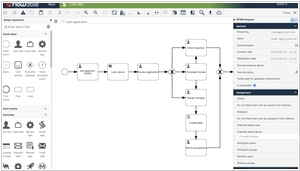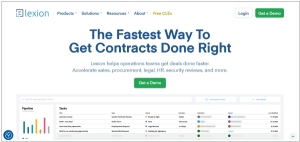Camunda vs Flowable
May 29, 2023 | Author: Michael Stromann
Camunda and Flowable are both popular open-source workflow automation and business process management (BPM) platforms, but they have some key differences.
1. Focus and Community: Camunda has a strong focus on workflow and process automation, providing a comprehensive suite of tools and capabilities for modeling, executing, and monitoring workflows. It has a large and active community of users and developers, contributing to its growth and continuous improvement. Flowable, on the other hand, not only offers workflow automation but also encompasses case management and decision automation. It provides a more holistic approach to BPM, allowing organizations to handle complex scenarios beyond traditional workflow processes.
2. Technical Features and Integration: Both platforms offer similar technical features such as process modeling, execution engines, user task management, and business rule engines. However, Camunda is often recognized for its flexibility and ease of integration with existing systems and tools. It provides extensive support for integrating with other systems through various APIs and connectors. Flowable also offers strong integration capabilities, including REST APIs and support for industry-standard protocols, but it may have a slightly steeper learning curve compared to Camunda.
3. Community and Enterprise Editions: Camunda offers a community edition that is free and open source, providing a strong foundation for workflow automation. Additionally, Camunda provides an enterprise edition with additional features, support, and scalability for organizations with more demanding requirements. Flowable, on the other hand, has a dual licensing model. It offers an open-source community edition and a commercial enterprise edition that provides additional features, support, and enterprise-grade capabilities.
See also: Top 10 BPM Software
1. Focus and Community: Camunda has a strong focus on workflow and process automation, providing a comprehensive suite of tools and capabilities for modeling, executing, and monitoring workflows. It has a large and active community of users and developers, contributing to its growth and continuous improvement. Flowable, on the other hand, not only offers workflow automation but also encompasses case management and decision automation. It provides a more holistic approach to BPM, allowing organizations to handle complex scenarios beyond traditional workflow processes.
2. Technical Features and Integration: Both platforms offer similar technical features such as process modeling, execution engines, user task management, and business rule engines. However, Camunda is often recognized for its flexibility and ease of integration with existing systems and tools. It provides extensive support for integrating with other systems through various APIs and connectors. Flowable also offers strong integration capabilities, including REST APIs and support for industry-standard protocols, but it may have a slightly steeper learning curve compared to Camunda.
3. Community and Enterprise Editions: Camunda offers a community edition that is free and open source, providing a strong foundation for workflow automation. Additionally, Camunda provides an enterprise edition with additional features, support, and scalability for organizations with more demanding requirements. Flowable, on the other hand, has a dual licensing model. It offers an open-source community edition and a commercial enterprise edition that provides additional features, support, and enterprise-grade capabilities.
See also: Top 10 BPM Software





